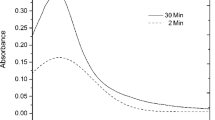Abstract
Polypyrrole–silver (PPy–Ag) nanocomposites with various silver contents have been synthesized via a kinetically favorable one-step chemical oxidative polymerization process. The oxidant, ammonium persulfate, was used to oxidize pyrrole monomer for growing chains of PPy. And AgNO3 was used as a precursor for metallic silver nanoparticles. The detailed characterization techniques, UV–Vis–NIR, fourier transform infrared spectroscopy, X-ray photoelectron spectroscopy, X-ray diffraction spectroscopy, field-emission scanning electron microscopy, and transmission electron microscopy (TEM), have been used to reveal electronic environment, structure, and morphology of composites as well as as-synthesized PPy. The synthesis environment prior to polymerization has also been investigated by absorption spectroscopy. The TEM images of PPy–Ag nanocomposites reveal that silver nanoparticles are deeply embedded into the polymer matrix in addition to surface adsorption. It is observed that the size distribution of inorganic nanoparticles (ca. 4–10 nm, depending on the metal ion concentrations) as well as structural morphology is altered by the initial concentrations of silver ions.








Similar content being viewed by others
References
Wise DL, Winek GE, Trantolo DJ, Copper TM, Gresser JD (1998) Electrical and optical polymer systems. Marcel Dekker Inc., New York
Rodriguez J, Grande HJ, Otero TF (1997) In: Nalwa HS (ed) Handbook of organic conductive molecules and polymers. Wiley, New York
Simonet J, Berthelot JR (1991) Electrochemistry: a technique to form, to modify and to characterize organic conducting polymers. Prog Solid State Chem 21:1–48
Sadki S, Schottland P, Brodie N, Sabouraud G (2000) The mechanisms of pyrrole electropolymerization. Chem Soc Rev 29:283–293
Scrosati B (1993) Applications of electroactive polymers. Chapman & Hall, London
Henglein A (1989) Small-particle research: physicochemical properties of extremely small colloidal metal and semiconductor particles. Chem Rev 89:1861–1873
Ullah MH, Chung WS, Kim I, Ha CS (2006) pH-Selective synthesis of monodisperse nanoparticles and 3D dendritic nanoclusters of CTAB-stabilized platinum for electrocatalytic O2 reduction. Small 2:870–873
Park JW, Ullah MH, Park SS, Ha CS (2007) Organic electroluminescent devices using quantum-size silver nanoparticles. J Mater Sci Mater Electron 18:S393–S397
Miao Y, Wu X, Chen J, Liu J, Qiu J (2008) Preparation of Au/polypyrrole composite nanoparticles and study of their electrocatalytical reduction to oxygen with (without) lacasse. Gold Bulletin 41:336–340
Ullah MH, Kim I, Ha CS (2006) Preparation and optical properties of colloidal silver nanoparticles at a high Ag+ concentration. Mater Lett 60:1496–1501
Mallick K, Witcomb MJ, Scurrell MS (2006) Formation of palladium nanoparticles in poly (o-methoxyaniline) macromolecule fibers: an in situ chemical synthesis method. Eur Phys J E 19:149–154
Cioffi N, Torsi L, Sabbatini L, Zambonin PG, Bleve-Zacheo T (2000) Electrosynthesis and characterisation of nanostructured palladium–polypyrrole composites. J Electroanal Chem 488:42–47
Henry MC, Hsueh CC, Timko BP, Freund MS (2001) Reaction of pyrrole and chloroauric acid a new route to composite colloids. J Electrochem Soc 148:D155–D162
Zhou Y, Itoh H, Uemura T, Naka K, Chujo Y (2002) Synthesis of novel stable nanometer-sized metal (M = Pd, Au, Pt) colloids protected by a π-conjugated polymer. Langmuir 18:277–283
Liu YC, Chuang TC (2003) Synthesis and characterization of gold/polypyrrole core–shell nanocomposites and elemental gold nanoparticles based on the gold-containing nanocomplexes prepared by electrochemical methods in aqueous solutions. J Phys Chem B 107:12383–12386
Dallas P, Niarchos D, Vrbanic D, Boukos N, Pejovnik S, Trapalis C, Petridis D (2007) Interfacial polymerization of pyrrole and in situ synthesis of polypyrrole/silver nanocomposites. Polymer 48:2007–2013
Chen A, Wang H, Li X (2005) One-step process to fabricate Ag-polypyrrole coaxial nanocables. Chem Commun 2005:1863–1864
Ullah MH, Kim I, Ha CS (2007) In-situ chemical synthesis of polypyrrole–Ag nanocomposite. Polymer Preprints 48:613–614
Malinauskas A (2001) Chemical deposition of conducting polymers. Polymer 42:3957–3972
Yang X, Lu Y (2005) Preparation of polypyrrole-coated silver nanoparticles by one-step UV-induced polymerization. Mater Lett 59:2484–2487
Ullah MH, Kim I, Ha CS (2006) In-situ preparation of binary-phase silver nanoparticles at a high Ag+ concentration. J Nanosci Nanotechnol 6:777–782
Chen A, Kamata K, Nakagawa M, Iyoda T, Wang H, Li X (2005) Formation process of silver–polypyrrole coaxial nanocables synthesized by redox reaction between AgNO3 and pyrrole in the presence of poly(vinylpyrrolidone). J Phys Chem B 109:18283–18288
Shen Y, Wan M (1998) In situ doping polymerization of pyrrole with sulfonic acid as a dopant. Synth Met 96:127–132
Liebsch A (1993) Surface plasmon dispersion of Ag. Phys Rev Lett 71:145
Savio L, Vattuone L, Rocca M (2000) Effect of surface interband transitions on surface plasmon dispersion: O/Ag(001). Phys Rev B 61:7324–7326
Omastová M, Pavlinec J, Pionteck J, Simon F, Košina S (1998) Chemical preparation and characterization of conductive poly(methyl methacrylate)/polypyrrole composites. Polymer 39:6559–6566
Pintér E, Patakfalvi R, Fülei T, Gingl Z, Dékány I, Visy C (2005) Characterization of polypyrrole–silver nanocomposites prepared in the presence of different dopants. J Phys Chem B 109:17474–17478
Acknowledgements
The work was supported by the National Research Foundation of Korea (NRF) Grant funded by the Ministry of Science, ICT, and Future Planning, Korea {Acceleration Research Program (NRF-2014 R1A2A111 054584); Pioneer Research Center Program (NRF-2010-0019308/2010-0019482); Brain Korea 21 Plus Program (21A2013800002)}.
Author information
Authors and Affiliations
Corresponding author
Rights and permissions
About this article
Cite this article
Habib Ullah, M., Ha, CS. In situ prepared polypyrrole–Ag nanocomposites: optical properties and morphology. J Mater Sci 51, 7536–7544 (2016). https://doi.org/10.1007/s10853-016-0033-2
Received:
Accepted:
Published:
Issue Date:
DOI: https://doi.org/10.1007/s10853-016-0033-2




